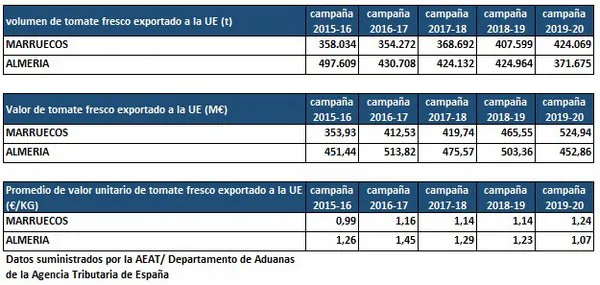Morocco, whose production schedule is very similar to that of Spain, is the latter's main competitor in terms of tomato production and marketing in the European Union. In fact, it has increased its sales by 18% over the last 4 campaigns, while Almería has seen them reduced by 25%. According to ICEX data, Moroccan fresh tomato exports to the European Union (424,000 t) from September 2019 to August 2020 are greater than those of Almeria within the same period (371,000 t). We have seen constant declines in recent campaigns.
As a consequence, the value of Moroccan fresh tomato sales to the European Union has been 14% higher than that achieved by Almeria, with the former reaching € 524 million, compared to the latter's € 452 million. If we look at the average price per unit last season, we see that the kilo of Moroccan fresh tomatoes was sold to Europe for € 1.24 / kg, while that of Almeria reached € 1.07 / kg.

It should be noted that around 27.1% of the protected horticultural area in Andalusia corresponds to tomato cultivation, with over 10,300 hectares and a production of around 936,000 tons.
According to data managed by the Council of Agriculture, strong growth has been observed in Morocco, which has gone from about 9,000 hectares in 2001 (when this country started to enjoy favorable conditions for trade with EU markets) to roughly 24,000 last year. This time, the acreage is expected to be expanded to 26,000 hectares (a large part of them belonging to European investors and producers).
But the most striking thing is the increase in imports of Moroccan fresh tomatoes in Spain, which have more than doubled in the last four seasons (from 35,700 tons to 79,900 tons). The same is happening in Andalusia, with an 88% rise in the import of Moroccan fresh tomatoes, and Almería, with a four-fold increase, from 3,350 tons in the 2015/16 campaign to 12,200 in 2019/20.
At ES Andalucía, we urge the regional government to fulfill its commitment to monitoring the fraudulent labeling of products that are sold as if they were of Spanish origin.
The Organization of Entities of the Social Agro-food Economy of Andalusia, ES Andalusia, looks after the interests of its associates and is involved in the promotion of exports and internationalization as a way to improve the value of the product and the entire value chain. At ES Andalucía, we are constantly in touch with official institutions to promote initiatives aimed at the social, labor and economic improvement of the associates, offering also advice linked to developments in the various agri-food sectors.
 For more information: www.esandalucia.org
For more information: www.esandalucia.org
